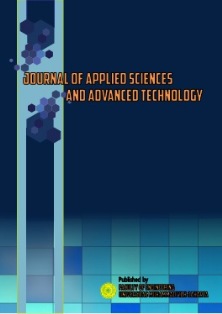Manufacture of Biodegradable Plastics from Cassava Starch (Manihot Escullenta) with Variable Glycerol Plasticizers and Chitosan Reinforcement
DOI:
https://doi.org/10.24853/jasat.7.1.1-6Keywords:
Biodegradable Plastic, Chitosan, Cassava Starch, Glycerol.Abstract
Biodegradable plastic is an alternative environmentally friendly packaging material because it is made from renewable materials and is scientifically easily degraded by microorganisms and by weather. Renewable material that is abundant in Indonesia is cassava which has high potential as a raw material for making biodegradable plastics. Purpose This study was conducted to determine the process of making biodegradable plastic from cassava starch, knowing the effect of adding glycerol and chitosan to the mechanical properties of biodegradable plastics, and know the characteristics of biodegradable plastics from the best conditions. The process of making biodegradable plastic from cassava starch begins with mixing cassava starch with water and processing until starch dough is formed. Next, glycerol is added to the starch dough and mixed until homogeneous. The final stage is chitosan added to the mixture and stirred until well mixed. The mixture is then heated and molded according to the desired shape. Biodegradable plastics produced from a mixture of cassava starch, glycerol, and chitosan have good mechanical properties and can decompose naturally in the environment for the study variables with concentrations of glycerol 2%,4%,6%,8%,10% and chitosan 1%,3%,5%,7%,9% in a mixture of 100 ml. Mechanical tests such as tensile strength, percent elongation and biodegradation of biodegradable plastics are carried out on product characteristics. The result of this study was to obtain the highest tensile strength in sample 1 of 3.41 Mpa and had an elongation of 68%. While the highest elongation in sample 3 was 130% and tensile strength was 0.26 MPa. The highest biodegradation result in sample 1 was 31.70% and the lowest in sample 5 was 6.55%.Downloads
References
Indriana, S. I. (2015). Pemanfaatan Tepung Kulit Singkong (Manihot Utilissima) Untuk Pembuatan Plastik Ramah Lingkungan (Biodegradable) Dengan Penambahan Gliserol Dari Minyak Jelantah.
Cengristitama., & Ramlan, S. (2022). Pengaruh Penambahan Plasticizer Gliserol dan Kitosan Terhadap Karakteristik Plastik Biodegradable Berbahan Dasar Pati Sukun. (TEDC Vol.16, No.2).
Ismaya, F., Fithriyah, N. H., & Hendrawati, T. Y. (2021). Pembuatan dan Karakterisasi Edible Film dari Nata De Coco dan Gliserol. 13(1). https://doi.org/10.24853/jurtek.13.1.81-88
Apriyansyah, Nugrahani Ratri. A., & Ismiyati. (2022). Preparation and Characterization of Mechanical Properties Improved Bioplastics from Rice Bran with Varying Glycerol Volume.
Maneking, E., Sangian, H., & Tongkukut, S. (2020). Pembuatan dan Karakterisasi Bioplastik Berbahan Dasar Biomassa dengan Plasticizer Gliserol. Jurnal MIPA (Vol. 9, No.1). https://ejournal.unsrat.ac.id/index.php/jmuo
Krisnadi, R., Handarni, Y., Udyani, K., & Kimia, J. T. (2019). Pengaruh Jenis Plasticizer Terhadap Karakteristik Plastik Biodegradable dari Bekatul Padi.
Yustinah., Noviyanti, S., Hasyim, U. H., Syamsudin AB. (2019). Pengaruh Penambahan Kitosan dalam Pembuatan Plastik Biodegradable dari Rumput Laut Gracilaria Sp dengan Pemlastik Sorbitol.
Selpiana., Jeo, F. R., & Yordan, K. (2020). Pembuatan Plastik Biodegradable dari Tepung Nasi Aking.
Marlina, L., Tsania, N., & Achmad, F. (2021). Pengaruh Variasi Penambahan Kitosan dan Gliserol Terhadap Karakteristik Plastik Biodegradable dari Pati Ubi Jalar (Vol. 15, Issue 2).
Elly Agustin, Y., & Samuel Padmawijaya, K. (2016). Sintesis Bioplastik dari Kitosan-Pati Kulit Pisang Kepok dengan Penambahan Zat Aditif.
Nafiah., Asyiah, I., & Fikti, K. (2017). Kajian Etnobotani Tanaman Singkong yang Berpotensi sebagai Obat oleh Masyarakat Kabupaten-Bondosowo. http://jurnal.unej.ac.id/index.php/STF
Aripin, S., Saing, B., & Kustiyah, E. (2017). Studi Pembuatan Bahan Alternatif Plastik Biodegradable dari Pati Ubi Jalar dengan Plasticizer Gliserol dengan Metode Melt Intercalation. Jurnal Teknik Mesin, 6(2), 18.
Dewi, S. R., Chairunisa, N. N., Nugrahani, R. A., Ningsih, T. D., Fithriyah, N. H., & Kosasih, M. (2020). Pembuatan dan Karakterisasi Kelarutan dalam Air dan Biodegradibilitas Bioplastik dari Campuran Dedak Padi-Jagung. Seminar Nasional Penelitian LPPM UMJ Website: http://jurnal.umj.ac.id/index.php/semnaslit E- http://jurnal.umj.ac.id/index.php/semnaslit
Nugraha, L. A., Triastianti, R. D., & Prihandoko, D. (2020). Uji Perbandingan Plastik Biodegradable Pati Singkong dan Pati Kentang terhadap Kekuatan Tarik dan Pemanjangan. Jurnal Rekayasa Lingkungan, 20.
Hartatik, Y., Nuriyah, L., & Iswarin. (2014). Pengaruh Komposisi Kitosan terhadap Sifat Mekanik dan Biodegradable Bioplastik.
Alim, M. D., Karangan, A., Suprihatin., & Nandini, A. (2023). Pemanfaatan Limbah Nasi Aking pada Pembuatan Bioplastik dengan Kitosan dan Plasticizer Gliserol. In Jurnal Teknik Kimia (Vol. 17, Issue 2).
Selpiana., Patricia., & Anggraeni, C. (2016). Pengaruh Penambahan Kitosan dan Gliserol pada Pembuatan Bioplastik dari Ampas Tebu dan Ampas Tahu. In Jurnal Teknik Kimia (Vol.22, No.1).
Hidayat, F., Syaubari., & Salima, R. (2020). Pemanfaatan Pati Tapioka dan Kitosan dalam Pembuatan Plastik Biodegradable dengan Penambahan Gliserol sebagai Plasticizer. Jurnal Litbang Industri, 10(1), 33. https://doi.org/10.24960/jli.v10i1.5970.33-38
Solekah, S., Sasria, N., & Dewanto, H. (2021). Pengaruh Penambahan Gliserol dan Kitosan Kulit Udang terhadap Biodegradasi dan Ketahanan Air Plastik Biodegradable. In Jurnal Ilmu Kimia dan Terapan (Vol. 8, Issue 2).
Nurhidayanti, N., Wardani, I., & Ilyas, N. (2021). Studi Optimasi Komposisi Gliserol dan Kitosan terhadap Karakteristik Sifat Fisik Plastik Biodegrable dari Limbah Nasi Aking dan Tepung Tapioka. In Jurnal Ecotrophic (Vol. 15, No.1, ISSN:2503-3395)
Downloads
Published
Issue
Section
License
COPYRIGHT POLICY
The author(s) of an article published in the Journal of Applied Sciences and Advanced Technology (JASAT) retains ownership of the intellectual property rights in work (s).
PUBLISHING RIGHTS
The author(s) of an article published in the Journal of Applied Sciences and Advanced Technology (JASAT) have unrestricted publication rights. The authors give the Journal of Applied Sciences and Advanced Technology (JASAT) the right to publish the article and designate the Faculty of Engineering Universitas Muhammadiyah Jakarta Publishing as the original publisher of the article.
LICENSING POLICY
JASAT is an open-access journal that follows the Creative Commons Non-Commercial 4.0 International License (CC BY-NC 4.0), which states that:

Under this license, the reusers must give appropriate credit, provide a link to the license, and indicate if changes were made. Users may do so in any reasonable manner, but not in any way that suggests the licensor endorses users or their use.
Please take the time to read the whole license agreement (https://creativecommons.org/licenses/by-nc/4.0/). As long as reusers follow the license conditions, the owner cannot withdraw these freedoms. The following components are included under this license:
 Attribution: Users must provide appropriate attribution, including a link to the license, and indicate whether or not they made any modifications. Users are free to do so reasonably, but not in a manner that indicates the licensee approves of their usage.
Attribution: Users must provide appropriate attribution, including a link to the license, and indicate whether or not they made any modifications. Users are free to do so reasonably, but not in a manner that indicates the licensee approves of their usage.
 NonCommercial: Users may not use the material for commercial purposes.
NonCommercial: Users may not use the material for commercial purposes.












_2.png)


1.png)

2.png)
